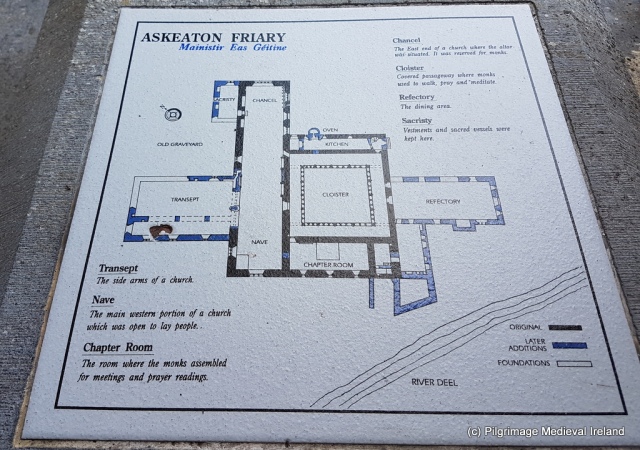A few weeks back I paid a visit to the wonderful Askeaton Friary in Co Limerick.

Askeaton Friary Co Limerick
The friary is located on the banks of the river Deel, at the edge of town just off the N69. According to the Monastic Ireland website The friary was founded in the year 1389 by either Gerald Fitzgerald the 3rd earl of Desmond and Lord Justice of Ireland, or in 1420 by James Fitzgerald the 7th earl of Desmond.
The friary seems to have survived the dissolution and a provincial chapter was held here in 1564. Shortly afterwards during the Desmond Wars the friary was taken over by Nicholas Malby and the friars were expelled.
The ruins of the friary are extensive and in a very good state of repair. The ruins date primarily to the fourteenth and fifteenth century and include a cloister, church and domestic buildings.

Plan of remains of Askeaton Friary showing building phases.
Today the friary is accessed through a modern graveyard on the east side of the monastic remains.

Door leading into the cloister in the south wall.
To enter the interior of the ruins and the cloister one must pass through a finely fifteenth century pointed doorway in the south wall. This doorway is opposite a spiral staircase that provides acces to the upper story of the east range.

Doorway on the east side south wall providing access to the cloister and the east range at Askeaton Friary.
As you enter this doorway and turn left you find an extremely well-preserved to the cloister.
The cloister consists of a central rectangular area surrounded by a covered walkway. The cloister was the heart of the monastery, a place of quiet contemplation and the means of communication between the monastic church and domestic buildings.
At Askeaton the cloister walkway has very finely carved arches. Each arch is composed of columns with moulded bases and capitals. In the northeast corner of the cloister, there is a carving of St Francis the patron saint of the Franciscan order. The saint is depicted in monastic robes with stigmata.
The cloister provides access to the church and the domestic buildings through a series of doors. The nave of the church is entered through a lovely pointed doorway with beautiful carvings on the base.
The church is a long building of fourteenth century date with an undivided nave and chancel.
The church has some very interesting features, including a triple sedilia and choir stalls in the east end of the south wall.

Triple sedilia and choir stalls in the east wall of the church.
Above the sedilia is a large plaque sixteenth century date, contemporary carved stones some and a second plaque (later insertions) and a finely carved tracery window.
The walls of the church still retain a number of hooded tomb niches, three in the south wall and one in the north wall.
The church also has some very finely carved tracery windows.
The remains of a later fifteenth century transept are found at the northwest end of the church building.
The transept provided space for additional altars dedicated to various saints and serving as mortuary, burial or chantry chapels for the community’s benefactors. In friaries the transept was often the location of a shrine to the Virgin Mary and was known as the Lady Chapel. (Monastic Ireland website)
A pointed doorway in the north wall connects the chancel to the sacristy. At the base of the doorways is a spiral carving. I wonder if it is a masons mark.
The sacristy has two floors. The ground floor was roofed with a barrel vault. The partial remains of the vaulting can still be seen in the north wall and a fireplace survives in this wall. The east gable gable wall is the most intact part of this room and contains a fine twin-light window,
Behind the sacristy is a large green area marked as the ‘old graveyard’ on the 1st edition Ordnance Survey map is located behind the church and sacristy. There are some large chunks of masonry from the transept walls scattered around the graveyard.
The domestic building of the friary also survive and are found on the east and west side of the clositer.
The east range includes the monastic kitchen. It is a two stories and the ground floor is roofed with a long barrel-vaulted ceiling. A finely carved fireplace is located towards the north end of the east wall.
The refectory or dining room,juts out of the southeast corner of the cloister. It is two stories in height and dates to circa fifteenth century.
The chapter room where monks conducted business also survives and is in good condition. It was locked when I visited so I could only peek in through the metal gate. with in the area are the tombs of the martyrs Bishop Patrick O’Healy and Fr Conn O’Rourke.
According to the wonderful Monastic Ireland website
A very fragmentary painting survives in the upper floor of the domestic ranges – a space that would have been reserved for the friars. It depicts a devotional image of the ‘Man of Sorrows’- showing Christ surrounded by the instruments of his Passion (http://www.monastic.ie/tour/askeaton-franciscan-friary/).
For a more in-depth discussion of the site check out the wonderful Monastic Ireland website.
References













































What a great site – and such wonderful photos. Inspired by your post, I read up abut stigmata. I had forgotten about St Francis.